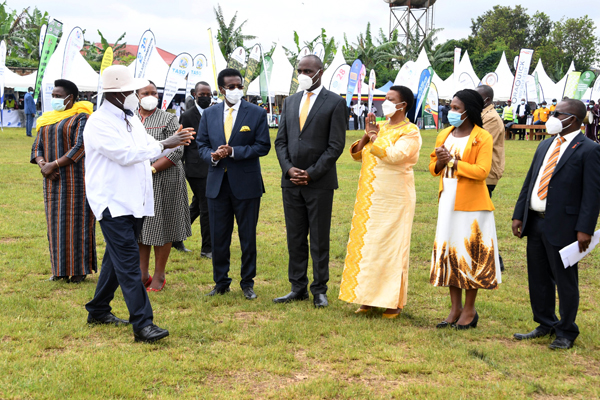Prime
Kabarole outlier in HIV/Aids fight

Miss Young Positive for western region Violet Kasiime, 21, speaks during celebrations to mark World Aids Day at Kyaitamba Primary School in Kabarole District on Thursday. PHOTO | ALEX ASHABA
What you need to know:
- Dr Stephen Kalyegira, the Kabarole District Health Officer, blamed the status quo on adult men who have unprotected sex with young girls aged between 13 and 18. This, he adds, explains why the prevalence of the virus is high among girls aged between 13 and 24.
As far as the HIV/Aids prevalence rate is concerned, Kabarole sticks out like a metaphorical sore thumb.
The western district’s prevalence rate stands at 14.6 per cent, which is well above the national average of 5.5 per cent.
Dr Stephen Kalyegira, the Kabarole District Health Officer, blamed the status quo on adult men who have unprotected sex with young girls aged between 13 and 18. This, he adds, explains why the prevalence of the virus is high among girls aged between 13 and 24.
Kabarole’s health management information system report for 2022 indicates that 8,488 people live with HIV/Aids in the district. More perplexing is the fact that 587 new infections were registered in the last quarter.
The district also lost 19 people to HIV/Aids out of the 236 clients who stopped taking antiretrovirals (ARVs).
“As a district, our target is to see that by 2030, we don’t get new infections, but we are still struggling to see that we achieve that [goal], which is still a challenge,” Ms Catherine Kemigabo, the Kabarole District HIV/Aids coordinator, said.
Work to be done
The most affected sub-counties as regards people infected with HIV/Aids include Kijura (1,750 people), Mugusu (960), Ruteete (812), Kabende (415) and Toro Kahuna health facility (482).
The condom uptake in Kabarole stands at 61 per cent. Ms Kemigabo adds that some people, especially those who sleep with commercial sexual workers, don’t use condoms, which increases the transmission rate.
“It’s a shame to see that we still have people who die of HIV/Aids and other related diseases. This is largely because people who start taking drugs later abandon them. Most couples don’t want to disclose it to their partners,” Mr Richard Rwabuhinga, the Kabarole District chairperson for the Aids Committee, said.
Kabarole commemorated World Aids Day on Thursday at Kyaitamba Primary School in Kijura Town Council. Mr Matia Mulumba, the town council chairperson, told Sunday Monitor that the reason why many people shun taking drugs is because “we don’t have a nearby health facility where people can access antiretrovirals.”
He also further noted that there is a growing problem of infections occasioned by “raping children.” Ms Violet Kasiime, who is Miss Young Positive for Western region 2022/2023, said only mindset change can rein in the epidemic.
“The challenge we have experienced, especially the youth, is stigma and discrimination, which resulted into many people declining to disclose [their status],” the 21-year-old revealed, reasoning that this explains “why we keep getting new people who are positive.”
Interventions
Kabarole District has been partnering with non-state actors such as Baylor Uganda and YAWE to reduce the spread of HIV/Aids. They have been using a test-and-treat policy where they have been encouraging people to know their status. Also, the majority of the health facilities in the district offer Pre-Exposure Prophylaxis (PrEP) and Post-Exposure Prophylaxis (PEP) as one of preventive measures.
The district has also been engaging cultural institutions such as Tooro Kingdom from 2019 to create awareness around HIV/Aids.
“The reason prevalence is high is because the majority of men don’t want to use condoms,” Ms Tina Birungi, a commercial sex worker attached to the Kabarole women health initiative, said, adding, “They rape people and some are infected. They end up spreading HIV/Aids.”
National Statistics
The 2020 Uganda Population-based HIV Impact Assessment (UPHIA) report indicates that the prevalence of HIV/Aids among adults aged 15 to 49 years declined from six per cent in 2016 to 5.5 per cent as of 2020.
The prevalence of HIV/Aids among adults of reproductive age 15 to 49 years was 5.5 per cent (7.1 per cent among women and 3.8 per cent among men), reflecting a slight decrease from six per cent in 2016-17 (7.5 per cent among women and 4.3 per cent among men).
The UPHIA 2020 survey sample of adults aged 15 years and older put HIV/Aids prevalence at 5.8 per cent (7.2 per cent among women and 4.3 per cent among men), corresponding to approximately 1.3 million adults living with HIV in Uganda.
The prevalence of HIV/Aids in adults 15 years and above was higher in urban areas (7.1 per cent) than in rural areas (5.2 percent).




